
by Fred Brewer | Jul 31, 2016 | Need To Know
In our last post, we sat down with Tom Smodic to discuss Google’s rapid rollout of changes. This week, we’re going to lay out a few of those changes and what we think they could mean for local businesses.
Disclaimer: Google is the King of leaving things open and somewhat vague, so none of this is meant to be a definitive take on Google’s action or intent. A lot of research, testing, and reading between the lines is required when Google is involved, and we’re simply passing along what we see and our inferences based on what we see. Enjoy!
Google Business Profile Joins Twitter & Facebook
Google recently announced that they will now be providing Google Business Profile (formerly GMB) support to users via social media (namely Twitter & Facebook Messenger). As long as you are tweeting or messaging during regular support hours, you can expect a prompt, knowledgeable response.
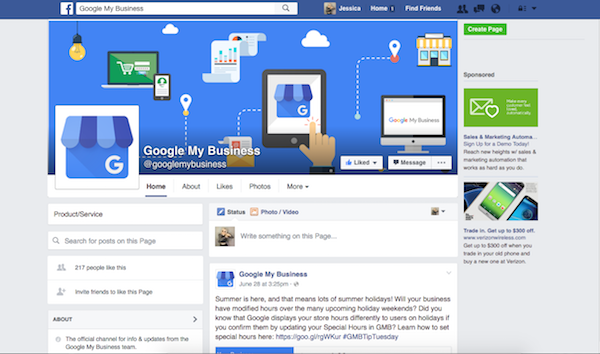
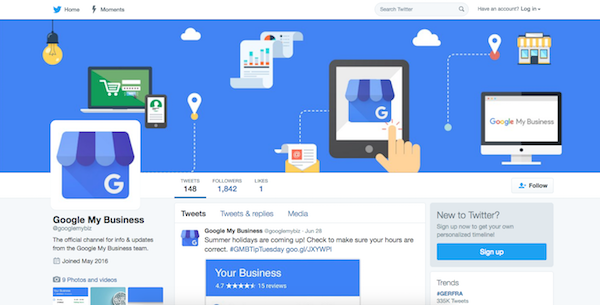
Why?
Let’s face it, if anyone knows users want fast results, it’s Google. This change could be an effort to simply provide a better user experience and faster resolutions to problems and issues. Why Facebook and Twitter? As Tom mentioned in our previous post, you have to go where the people are. Offering support to users through multiple channels, not just their own, shows that even Google knows this to be true.
Of course, this change could also have come about as a result of user feedback. People may have been asking why swift Google Business Profile support wasn’t available through social media channels and Google may have decided it was a worthwhile venture.
Whatever their reasoning, we see this as being a good thing that will hopefully make receiving prompt support easier and less agonizing.
Google’s Testing Video Verification
GBP has announced it is experimenting with video calls for business verification.
Why?
For as long as we can remember, one of Google’s main business verification processes has involved waiting for a post card to arrive by snail mail. Once it arrives, you enter the pin online where prompted and your business is verified. The problem is, snail mail is anything but fast and reliable, and sometimes the post card never arrives. In many cases, the business owner doesn’t finish the process and these pages don’t get verified.
Now, however, you can simply do a video call with a Googler to get the verification ball rolling. On a forum, a Googler mentions that, although you’re under no obligation to try this new method of verification, they hope “you’ll find it quick and convenient.”
So, perhaps video verification is Google’s attempt to cut down on spam and encourage business owners to complete the verification process by making it easier and faster. However, the video call must be conducted from either your workplace or your vehicle, which some business owners might find invasive. You’re encouraged to show your workspace, logo, and even the tools you use to the Googler (if you video verify from your workplace), and show your license plate, tools, and business logo on your vehicle to the Googler (if you video verify from your vehicle).
We have a feeling some business owners will be hesitant to verify using this method, and it seems that Google might have the same feeling. The Local Search Forum states:
“Not excited about video verification? If you’d prefer to not take part in our video experiment, please let us know. (We’ll wait to hear back from you before taking any further action.)”
Again, we think this new verification option is perhaps partially designed with the user in mind and partially designed to reduce spam. After all, it’s hard to spam with video, especially when you’re showing the Googler around.
Google Has Introduced Paid Ads to the Local Pack
For a while now, we’ve watched the local real estate in search results shrink. The local pack has gone down from a 7 pack, to a 5 pack, to a 3 pack. And now, one of those 3 is a paid ad.
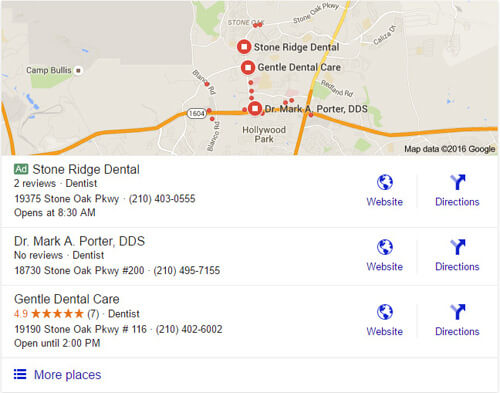
Why?
Money! Google isn’t just a search engine, it’s an advertising platform. Like any business, they want to make money! And with the end goal of creating a seamless experience across mobile, tablet, and desktop, they’re dealing with less screen space in which to place those ads.
Honestly, we’re not all that surprised that this happened, but it does give local businesses without the budget for ads a disadvantage by removing 33 1/3% of the local pack space. (It’s ok Google – we’re not mad, we’re just disappointed.)
Now, perhaps more than ever, having a constant influx of good reviews is vital. For more on this Google change and what we think it means for your business, read our interview with Tom Smodic.
Paid Ads Appear in Google Maps
Just as we’ve seen paid ads enter the local pack, Google has also rolled out paid ads in Google Maps.
On desktop, Google maps shows these ads in the list of search results just to the left of the map, as well as on the map itself. You’ll see a purple icon (indicating the ad), and if clicked on, the ad will display more information (such as a Directions button and business details).
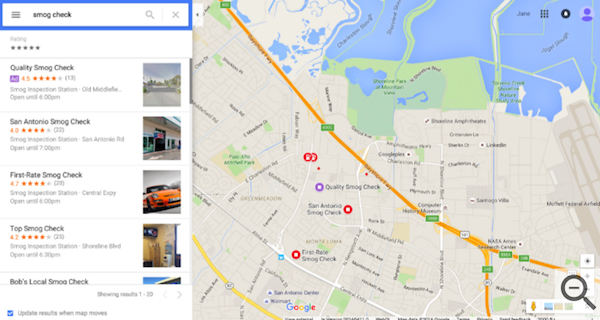
On mobile, the ad will appear on the map itself and on the list below the map. Once again, a purple icon will indicate that this is in fact an ad, and if clicked on, you may see things like a Call button and a Directions button. Your ad can also reveal things like customer reviews and hours, if clicked.
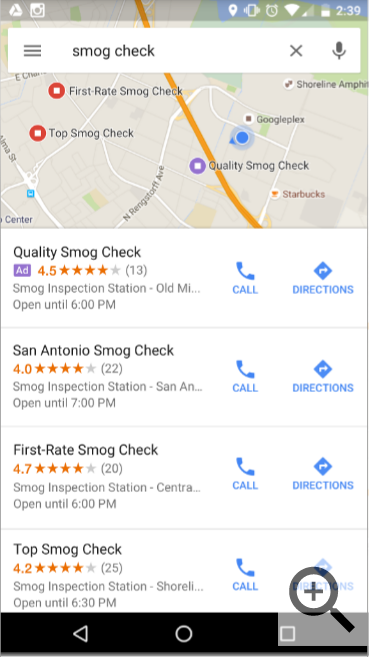
Why?
We see this as an indication that Google is paying more attention to brick-and-mortar businesses. And considering how many people are using Google maps, it’s no surprise that Google has decided to monetize (to a degree) this area of search.
Whether you decide to pay to play or not, make sure your map listing is right! Nearly one-third of all mobile searches have local intent, and if your map listing is incorrect, you’re going to miss out on business, especially if you have a brick-and-mortar business.
Change Is Inevitable
These are just a few of the changes that Google has rolled out lately. Although we can’t tell you exactly what Google will do in the future, one thing you can count on is for us to watch with a close eye and stay on top of these changes. And remember, even though you can’t control what happens in the world of search, you can control the value you deliver to your customers. So get out there and give them your best!

by Fred Brewer | Jul 15, 2016 | Need To Know
It’s no secret that things are always changing with the Wild Wide Web, but if you feel like changes are happening at an accelerated speed as of late, you’re not alone. This week, we sat down with Tom Smodic, our Marketing Manager and former Lead Account Manager. His chosen week of vacation this summer just so happened to align with one of Google’s biggest recent changes: the addition of an Ad to the local pack. We’ve asked him to talk about how fast things are changing and what this change means for small business owners. Here are some of the highlights.
Tom: I was gone a week, and the biggest change I saw was that Google started to monetize the local pack, which is different than organic and different than Google Ads.
For those of you who don’t know, the local pack, which is an area specifically reserved for local businesses, was at one time a seven spot, then five, then three. Now, for all intents and purposes, it’s a two spot.
Tom: Two out of the three are based on whatever algorithm Google has for local service businesses, but then the third can be paid. Whether that’s going to impact people’s decision-making has yet to be seen because it hasn’t fully rolled out yet. Are people going to care that one of these is an Ad or are they just looking to see where things are located?
Were you surprised that Google took this step and sort of crept into the local pack space?
Tom: It was not so much a shock, not so much a surprise. We’ve seen Google looking at how to change that space, whether it was the “Request a Contractor,” “Request A Quote,” and things like that, or things like this. They’re always looking to deliver results. But what you have to remember is that Google is a Search Engine, but they’re also an Advertising Platform, and they’re in it to make money. They’re not in it for altruistic reasons, they’re in it to make money. And if they find a way to do that without disrupting everything that they’ve kind of built their reputation on, they’re going to do it. So, I think we’re just seeing that trend continue.
Do you think this trend has picked up any momentum or simply remained steady?
Tom: I think it’s accelerated since I’ve been working here, just the amount of changes. They’re looking to do some more things in real time, like updates and search results, as opposed to set updates and stuff like that. It’s not that you’ll have a change like this every week, but Google’s always looking. And it’s not like there’s going to be a huge announcement or anything like that. You’re not going to get an update on your phone telling you what happened, it just kind of does. And it’s up to us to stay on top of that as best we can so we can answer the questions that may come up from our clients. That’s part of the ongoing day-to-day thing that a lot of people don’t realize. Because it’s changing, we have to stay on top of the landscape. If we stopped reading two years ago and just said, “Well, we know how this works,” or “We know what we’re doing,” we’d be in trouble because a lot of it has changed since then. We have to keep up to date. I just happened to pick the one week where Google made a significant change, though it’s yet to be seen if people will even notice or care.
Until we see whether this affects people’s decision-making when searching for local services, what advice do you have for business owners?
Tom: It still boils down to having good reviews. If you’re running your company well and delivering good service – from the first phone call that the customer makes to your company to the final follow-up and anything beyond that – if you’re delivering the right customer service to them and are friendly, don’t overcharge, or do those things that customers don’t like, they’ll be more inclined to leave a good review. And you won’t be scrambling to keep up with somebody and keep reviews fresh. It all comes back to that. Are you delivering value to your customer base and are you doing a good job of it? Whether it’s online or offline, your customers are going to talk to people – whether they leave a good review or they go tell their neighbor. Run your company well and make sure your customers are satisfied. Let them know that you appreciate their business and that you’d really appreciate it if they shared their experience by writing you a review on Facebook or Google.
Unfortunately, most people aren’t going to just write reviews unless they’re dissatisfied, so you’ve got to ask. And believe me, reviews matter! BrightLocal just conducted a survey and showed users a mock-up of the new local pack with an Ad. The third business got more clicks even though it wasn’t first in the pack. Why? Because it had good reviews!

Do you think a lot of the reasoning behind the acceleration of changes has to do with mobile?
Tom: Yeah, I think mobile is the reason for it. When I started, mobile was there, but there wasn’t that big of an emphasis on it. Google’s trying to create the same experience across both desktop and mobile. Searching on mobile, you’re looking for more real time results, especially when you’re looking for gas stations, places to eat, and things like that. Google knows they have a limited window to deliver the right service to the right person at the right time. So, whether it’s paid for or it’s just through organic search results, they know they have to get it right sooner. Whereas on desktop, it may be a little less time-sensitive.
But not only that, there’s less screen space with mobile. There’s just not as much real estate and they’re trying to put the most relevant result in front of the right person at the right time. So yeah, I think mobile plays into it and probably rightfully so. I don’t think desktop’s going to go away any time soon, but for these types of searches, time-sensitive searches, people on the go, Google knows they have to get it right. And I think that trend’s only going to continue.
Do you think we’re headed in the direction where business owners are going to have to invest in both organic and paid search?
Tom: I think there’s going to be a time when that is true, especially for the smaller guys. How much will need to be invested in paid, I’m not sure, but I think, just with the way Google’s moving, it could end up being a full front page of paid search results. That could just be it. Now whether or not, as that happens, people start to distrust the results is yet to be seen. Again, people might not even care. So, I think it kind of depends on where you’re located and your market. Every market is different. I think the thing to keep in mind is, people are not buying services or products from a company or a brand even, they’re buying from people. So, yes, you want to show up and you want to be in search results, and there might be a time where you have to pay for that, but there’s a lot that you can do offline. Like I said, focus on your systems, focus on your processes, focus on the people that you hire, because you can control those. You can’t always control Google’s algorithms – people think we can, but unfortunately we really can’t. Though I wish we could!
It’s hard to say what Google will really do, but the latest changes just suggest they’re looking to make money in any way they can. Just like any other business, you kind of have to adjust to where your customers are. But for people to go to another Search Engine would take a colossal fail on Google’s part – they’d have to really screw up the user experience to drive people away at this point.
However, I do think more people are going to start looking for businesses on Facebook, Yelp, Instagram, etc., in addition to Google. They’re going to look in multiple places to research a business beforehand. I think they’ll look to local groups and within local communities, paying more attention to the local area and wanting to stay within local. And that’s an advantage that local service businesses have that big brands don’t – they’re more personable & approachable, and you can leverage that by being a part of the community, being visible, being active.
Establish your brand and put yourself out there in your community so that people know who you are and want to do business with you specifically. It’s more than TV commercials and radio – be a resource for those in your area, sponsor little league teams, refer your customers to other local businesses.
There are ways it can be done, but I think in terms of pure search, there might be a time where you do have to allocate some funds for paid search. But then, what do you do after? What’s the experience like after the person finds you? I mean, these are the things you need to think about. They can find you, but if you have bad reviews, no reviews, or are perceived to provide a bad customer experience, then they’re going to go to somebody else, regardless of how far up or down on the first page of search results you are.
Even if you get lucky and capture that click or phone call because you’re first in organic and first in the maps, if the person picking up the phone has the wrong tone, you could lose the customer that way. So you have to be cognizant from the very beginning, all the way to the end of service, and be consistent. Like I said, you might get that click or that call, but what happens after that is ultimately in your control and will determine if they do business with you and come back to you. If you’re in business, you’re in the people business, regardless of your industry. Search may change, but that’s not going to change
So, we’ll just have to wait and see with Google.






